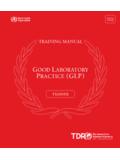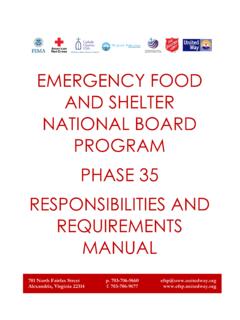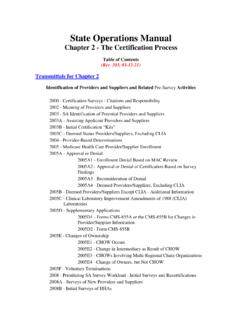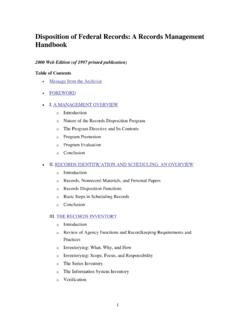Transcription of Third edition - World Health Organization
1 laboratory biosafety manual Third edition World Health Organization Geneva 2004. WHO Library Cataloguing-in-Publication Data World Health Organization . laboratory biosafety manual . 3rd ed. of biohazards - methods - standards infection - prevention and control ISBN 92 4 154650 6 (LC/NLM classification: QY 25) WHO/CDS/CSR/ This publication was supported by Grant/Cooperative Agreement Number U50/CCU012445-08. from the Centers for Disease Control and Prevention (CDC), Atlanta, GA, USA. Its contents are solely the responsibility of the authors and do not necessarily represent the official views of the CDC. World Health Organization 2004. All rights reserved.
2 Publications of the World Health Organization can be obtained from Marketing and Dissemination, World Health Organization , 20 Avenue Appia, 1211 Geneva 27, Switzerland (tel: +41 22. 791 2476; fax: +41 22 791 4857; email: Requests for permission to reproduce or translate WHO publications whether for sale or for noncommercial distribution should be addressed to Publications, at the above address (fax: +41 22 791 4806; email: The designations employed and the presentation of the material in this publication do not imply the expression of any opinion whatsoever on the part of the World Health Organization concerning the legal status of any country, territory, city or area or of its authorities, or concerning the delimitation of its frontiers or boundaries.))
3 Dotted lines on maps represent approximate border lines for which there may not yet be full agreement. The mention of specific companies or of certain manufacturers' products does not imply that they are endorsed or recommended by the World Health Organization in preference to others of a similar nature that are not mentioned. Errors and omissions excepted, the names of proprietary products are distinguished by initial capital letters. The World Health Organization does not warrant that the information contained in this publication is complete and correct and shall not be liable for any damages incurred as a result of its use. Designed by minimum graphics Printed in Malta Contents Foreword vii Acknowledgements viii 1.
4 General principles 1. Introduction 1. PART I. biosafety guidelines 5. 2. Microbiological risk assessment 7. Specimens for which there is limited information 8. Risk assessment and genetically modified microorganisms 8. 3. Basic laboratories biosafety Levels 1 and 2 9. Code of practice 9. laboratory design and facilities 12. laboratory equipment 14. Health and medical surveillance 16. Training 16. Waste handling 17. Chemical, fire, electrical, radiation and equipment safety 19. 4. The containment laboratory biosafety Level 3 20. Code of practice 20. laboratory design and facilities 21. laboratory equipment 22. Health and medical surveillance 22.
5 5. The maximum containment laboratory biosafety Level 4 25. Code of practice 25. laboratory design and facilities 25. 6. laboratory animal facilities 28. Animal facility biosafety Level 1 29. Animal facility biosafety Level 2 29. Animal facility biosafety Level 3 30. Animal facility biosafety Level 4 31. Invertebrates 32. 7. Guidelines for laboratory /facility commissioning 33. 8. Guidelines for laboratory /facility certification 36. iii . laboratory biosafety manual . PART II. laboratory biosecurity 45. 9. laboratory biosecurity concepts 47. PART III. laboratory equipment 49. 10. Biological safety cabinets 51. Class I biological safety cabinet 51.
6 Class II biological safety cabinets 53. Class III biological safety cabinet 56. Biological safety cabinet air connections 56. Selection of a biological safety cabinet 57. Using biological safety cabinets in the laboratory 57. 11. Safety equipment 61. Negative-pressure flexible-film isolators 61. Pipetting aids 63. Homogenizers, shakers, blenders and sonicators 63. Disposable transfer loops 64. Microincinerators 64. Personal protective equipment and clothing 64. PART IV. Good microbiological techniques 67. 12. laboratory techniques 69. Safe handling of specimens in the laboratory 69. Use of pipettes and pipetting aids 70. Avoiding the dispersal of infectious materials 70.
7 Use of biological safety cabinets 70. Avoiding ingestion of infectious materials and contact with skin and eyes 71. Avoiding injection of infectious materials 71. Separation of serum 72. Use of centrifuges 72. Use of homogenizers, shakers, blenders and sonicators 73. Use of tissue grinders 73. Care and use of refrigerators and freezers 73. Opening of ampoules containing lyophilized infectious materials 74. Storage of ampoules containing infectious materials 74. Standard precautions with blood and other body fluids, tissues and excreta 74. Precautions with materials that may contain prions 76. 13. Contingency plans and emergency procedures 78. Contingency plan 78.
8 Emergency procedures for microbiological laboratories 79. 14. Disinfection and sterilization 82. Definitions 82. Cleaning laboratory materials 83. iv . CONTENTS. Chemical germicides 83. Local environmental decontamination 88. Decontamination of biological safety cabinets 89. Hand-washing/hand decontamination 90. Heat disinfection and sterilization 90. Incineration 92. Disposal 93. 15. Introduction to the transport of infectious substances 94. International transport regulations 94. The basic triple packaging system 95. Spill clean-up procedure 95. PART V. Introduction to biotechnology 99. 16. biosafety and recombinant DNA technology 101. biosafety considerations for biological expression systems 102.
9 biosafety considerations for expression vectors 102. Viral vectors for gene transfer 102. Transgenic and knock-out animals 102. Transgenic plants 103. Risk assessments for genetically modified organisms 103. Further considerations 104. PART VI. Chemical, fire and electrical safety 105. 17. Hazardous chemicals 107. Routes of exposure 107. Storage of chemicals 107. General rules regarding chemical incompatibilities 107. Toxic effects of chemicals 107. Explosive chemicals 108. Chemical spills 108. Compressed and liquefied gases 109. 18. Additional laboratory hazards 110. Fire hazards 110. Electrical hazards 111. Noise 111. Ionizing radiation 111.
10 PART VII. Safety Organization and training 115. 19. The biosafety officer and biosafety committee 117. biosafety officer 117. biosafety committee 118. v . laboratory biosafety manual . 20. Safety for support staff 119. Engineering and building maintenance services 119. Cleaning (domestic) services 119. 21. Training programmes 120. PART VIII. Safety checklist 123. 22. Safety checklist 125. laboratory premises 125. Storage facilities 125. Sanitation and staff facilities 126. Heating and ventilation 126. Lighting 126. Services 126. laboratory biosecurity 127. Fire prevention and fire protection 127. Flammable liquid storage 128. Compressed and liquefied gases 128.
















